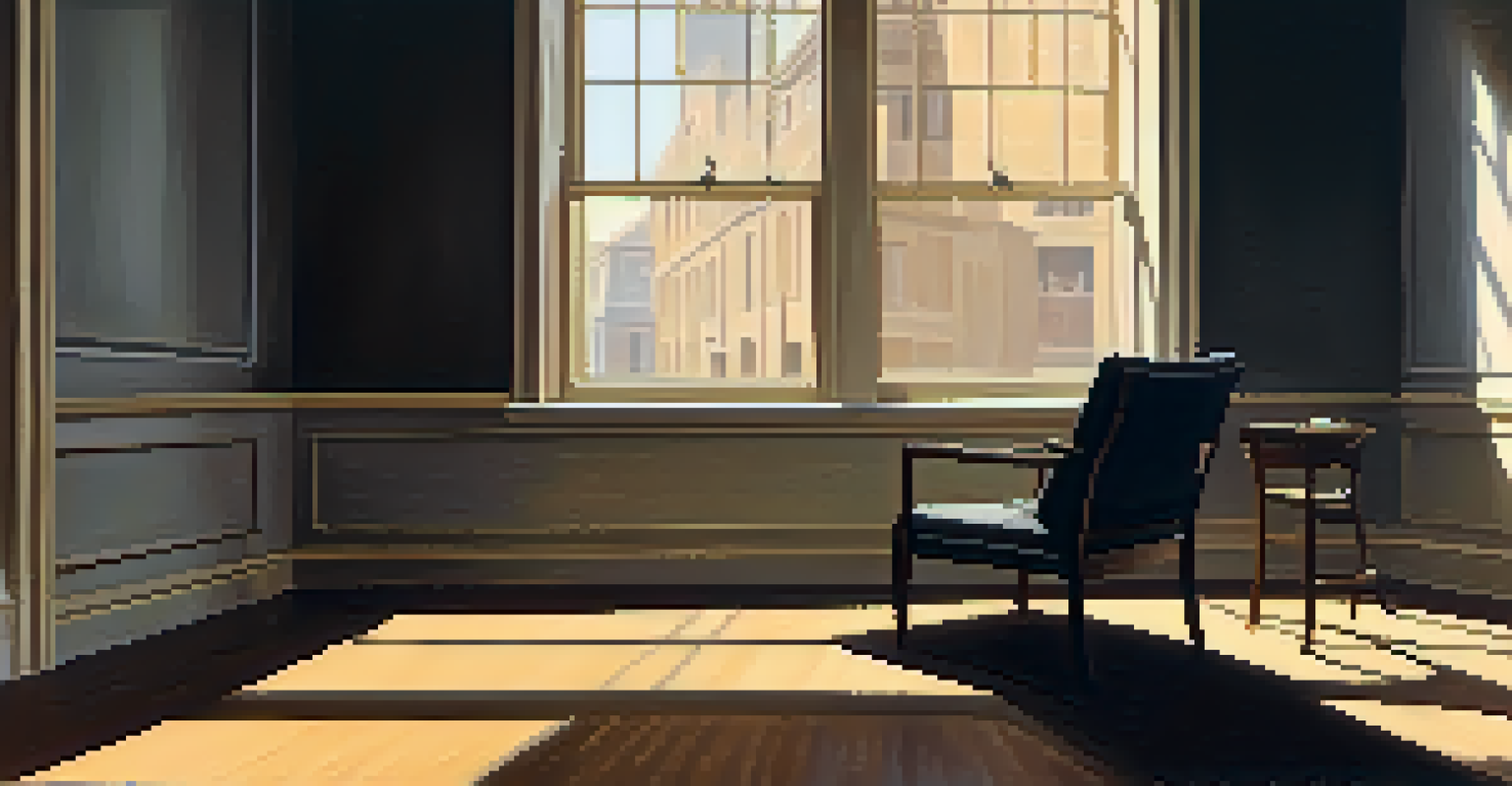Symbolism in Cinematography: Visual Metaphors in Film

Understanding Symbolism in Cinematography
Symbolism in cinematography refers to the use of visual elements to convey deeper meanings, emotions, and themes. Just like a painter uses colors to express feelings, filmmakers use imagery to enhance storytelling. This can include everything from lighting and color palettes to specific objects placed within a scene.
The camera is a great storyteller, and the images it captures are powerful symbols of our thoughts and emotions.
For instance, a dimly lit room can evoke feelings of isolation or despair, while a warm, sunlit landscape might symbolize hope and joy. By understanding these symbolic elements, viewers can gain a richer appreciation of the film's narrative and emotional undertones.
Ultimately, symbolism in cinematography invites the audience to engage more actively with the story, encouraging them to interpret visual cues and connect with the characters on a deeper level.
The Role of Color in Symbolism
Color is one of the most powerful tools filmmakers use to symbolize emotions and themes. Different colors can evoke specific feelings; for instance, red often symbolizes passion or danger, while blue can represent calmness or sadness. By carefully selecting colors, directors can guide audience perceptions subtly.

Consider the film 'The Sixth Sense,' where the color red is consistently used to signify the presence of the supernatural. This clever use of color not only creates suspense but also deepens the emotional resonance of the story. Every time you see red, you instinctively brace yourself for something significant.
Symbolism Enhances Storytelling
Symbolism in cinematography uses visual elements to convey deeper meanings, engaging the audience and enriching the narrative.
Thus, color in cinematography goes beyond mere aesthetics; it serves as a language of its own, helping to communicate complex ideas and emotions without a single word being spoken.
Lighting as a Symbolic Element
Lighting is another crucial element that contributes to the symbolic nature of cinematography. The way a scene is lit can dramatically change the mood or atmosphere, influencing how viewers feel about what they're seeing. Bright, harsh lighting might create a sense of discomfort, while soft, diffused lighting can evoke warmth and intimacy.
In filmmaking, every detail matters. From the color of a wall to the way a character is lit, each element tells a part of the story.
In films like 'Blade Runner,' the use of low-key lighting creates a noir aesthetic, symbolizing themes of isolation and moral ambiguity. The interplay of shadows and light not only sets the tone but also mirrors the internal struggles of the characters.
Through strategic lighting choices, filmmakers can craft a visual narrative that enhances the storytelling, guiding the audience's emotional response and highlighting the film's underlying themes.
Symbolic Objects and Their Meanings
Objects within a film can serve as potent symbols, often representing abstract concepts or character traits. For instance, a broken clock might symbolize the passage of time or lost opportunities, while a blooming flower can represent growth and renewal. These objects often resonate with viewers on a personal level, inviting them to reflect on their significance.
Take 'The Great Gatsby,' where the green light at the end of Daisy's dock symbolizes Gatsby's unattainable dreams and desires. This simple object becomes a powerful metaphor for hope and longing, encapsulating the film's central theme of the American Dream.
Color and Emotion Connection
Colors in film serve as powerful symbols, evoking specific emotions and guiding audience perceptions subtly.
By incorporating such symbolic objects, filmmakers enrich their narratives, allowing audiences to glean deeper meanings and connect with the characters' journeys.
The Power of Composition in Symbolism
Composition refers to how elements are arranged within a frame, and it plays a significant role in conveying symbolism. The placement of characters, objects, and backgrounds can suggest relationships, tensions, or emotions. For example, a character positioned alone in a corner of the frame might symbolize isolation or despair.
In 'The Shawshank Redemption,' the framing of Andy Dufresne behind bars consistently reinforces his entrapment and desire for freedom. Each carefully composed shot serves to highlight his struggles and aspirations, making the audience more empathetic to his plight.
Thus, composition is not just about aesthetics; it's a powerful storytelling tool that shapes how viewers interpret a scene and its underlying messages.
Sound and Symbolism in Cinematography
While we often think of visuals in cinematography, sound also plays a critical role in creating symbolism. The use of music, sound effects, and silence can evoke emotions and enhance the symbolic nature of a scene. For instance, a haunting melody can underscore feelings of nostalgia or loss, while abrupt silence can create tension.
In 'Inception,' the recurring use of the song 'Non, Je Ne Regrette Rien' symbolizes the characters' desire to return to reality and the consequences of their choices. The sound becomes a metaphor for their internal struggles and the complexity of their dreams.
Cultural Symbols Influence Perception
Cultural symbols reflect societal values and enhance storytelling, creating a connection with diverse audiences.
By intertwining sound with visual symbolism, filmmakers create a multi-layered experience that resonates deeply with audiences, adding another dimension to storytelling.
Cultural Symbols in Film
Cultural symbols can significantly influence how stories are perceived and interpreted in film. These symbols often reflect societal values, beliefs, and traditions, allowing filmmakers to connect with audiences on a cultural level. For instance, the use of specific colors, attire, or rituals can evoke a particular cultural context that enriches the narrative.
In films like 'Coco,' the Day of the Dead celebrations serve as a vibrant backdrop, symbolizing family, memory, and the connection between the living and the deceased. This cultural representation not only adds authenticity but also invites viewers to reflect on their own values and traditions.

By incorporating cultural symbols into cinematography, filmmakers create a shared language that resonates with diverse audiences, ultimately enhancing the storytelling experience.
Conclusion: The Impact of Symbolism in Cinematography
In conclusion, symbolism in cinematography is a vital aspect of storytelling that enriches the viewer's experience. From color and lighting to objects and sound, each element serves a purpose, conveying deeper meanings and emotions that resonate long after the credits roll. Understanding these visual metaphors allows audiences to engage with films on a more profound level.
As you explore various films, take a moment to appreciate the symbolic choices made by filmmakers. The next time you watch a movie, consider how the visuals enhance the narrative and what deeper messages might be hidden within the frames.
Ultimately, symbolism in cinematography invites us to see beyond the surface, transforming our viewing experience into a journey of introspection and connection.